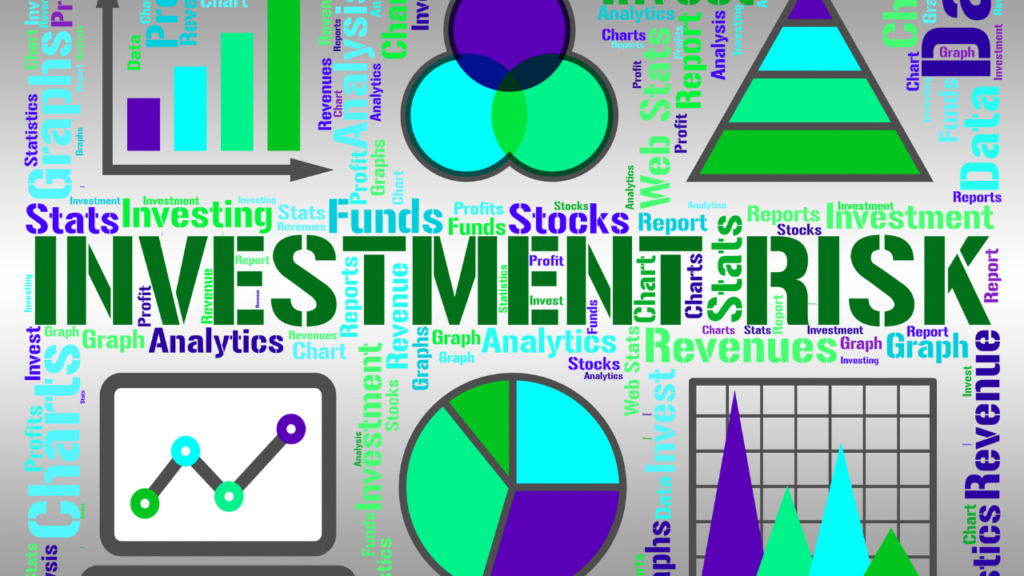
When investors put their money into various sorts of assets or investment alternatives, they anticipate a specific proportion of their money back. But every investment comes with potential gains and investment risks of losing capital.
Every investment has some level of risk. These risks are not entirely eliminated while investing. Notwithstanding the matter how well-diversified your portfolio is, different investing risks exist at all times.
Table of Contents
What is an investment risk
“Successful investment is about risk management, not risk avoidance. The basis of investment management is risk identification, not return management.” This was what the originator of value investing, Benjamin Graham, had to comment about investment risk.

The threat of jeopardizing some or all of one’s initial investment is referred to as investment risk. Each sort of investment is related with investment risk, albeit the risk may vary in accordance. There is no such thing as a certainty in investing.
For example, investing in fixed-income bonds or debentures has very low risk, but engaging in securities, shares, stocks, and options involves a larger risk. Investors buy based on their risk tolerance or risk profile. In general, the smaller the risk, the lower the possible return, and higher the risk, higher the return. It is up to the investor to select how many eggs to place in possibly risky baskets and how much to place in less risky ventures.
What are the main types of investment risks that investors need to factor in while investing
Before investing, investors should have a basic awareness of key investment risks. This will allow them to monitor investment risk comprehensively, avoiding huge and avoidable losses. Understanding the many forms of financial hazards will assist you in determining how much exposure, and to what sorts of risk, you’re prepared to take.
Let us look at some of the important investment hazards that investors should be aware of while investing.
Inflation risk

This is the most basic risk to which all investors are susceptible. Inflation is defined as a widespread increase in prices. Inflation risk indicates the loss of buying power of your money, or the pace at which your funds loses value with time. In theory, inflation takes away at the profits on your assets, diminishing the buying power of your money. So, in effort to prevent a loss on the initial invested, your investment must outperform at least the inflation rate. If the value of your assets does not keep pace with inflation, you may be missing out on an actual net return, which is a danger.
Debt instruments such as Bonds, fixed deposits, and government securities often provide lower returns and may or may not be able to combat inflation. Large cap equities, mutual funds, and gold, on the other hand, may typically outperform inflation in the long run.
Credit risk
Credit risk refers to the risk of a borrower, corporation, or government defaulting on a loan. In every debt deal, the borrower consents to pay the lender interest in addition to the principal. Because of financial difficulties, the borrower may be unable to pay either the interest or principal to the investors or lenders, resulting in a failure on its commitments. The chance of a borrower faltering on his loan commitments and missing to refund the principal, interest, or both is referred to as credit risk.
Bond market borrowers include the government, financial institutions, public sector organizations (PSUs), and private firms. Credit risk is minimal for government securities and bonds, as well as T-Bills issued by the RBI, because the government or RBI would not default under any circumstances, excepting an unusual economic catastrophe. On the other hand, Corporate bonds have the largest default risk but also the highest bond yields.
Credit risk often increases in the case of private issuers during periods of economic instability.
Investors should bear in mind that if the interest rate on a bond or the interest rate on a fixed deposit is typically high, this might indicate that the credit risk is significant. Bonds having a lower default risk are called investment grade, whereas bonds with a higher default risk are classified as high yield or junk bonds. As a result, before engaging in such products, always verify their credit ratings. Bond rating agencies can help investors discern which debt instruments are investment-grade and which ones are junk.
Liquidity risk
The risk of not being able to sell investments at a reasonable price and turn them into cash is known as liquidity risk. This is the likelihood that your investment will be unable to be exchanged at fair value into cash when desired, or that you will be unable to find a purchaser of your securities in the market when you require cash. Due to insufficient market liquidity, if an investment cannot be sold quickly enough to avoid squandering your initial investment sum, you may be forced to sell at a lower price, so jeopardizing the value of your investment.
Property investments have the most liquidity risk since it might take months or even years to sell at the best rate. It is also high for assets such as sovereign gold bonds, PPFs, or investments with lock-in periods, where there could be no liquidity for several years at first. Short-term liquidity risk is considerable for stock investments, while long-term liquidity risk is negligible.
The liquidity of an asset might vary according to economic conditions. Due to low trading activity, it is conceivable that you may find it difficult to sell your shares swiftly and at a best price in the stock market. In these cases, liquidity risk is also known as marketability risk. To reduce this risk, invest in stocks and bonds of firms that are regularly transacted and hence really in demand.
Interest rate risk

This risk implies that the value of your investment will fluctuate owing to market interest rate changes. Interest rate risk mostly affects debt securities, but it also affects other types of investments. Bonds and convertible notes are directly influenced by interest rate swings since their prices vary inversely in response to changes in interest rates. That is, if interest rates rise, the market value of debt instruments declines, and vice versa.
The impact of interest rate changes on equity products such as stocks or mutual funds is more indirect. If interest rates increase, a company’s capacity to borrow may be hampered, or its debt repayment costs may increase. As a result, the company’s share price may fall.
Similarly, higher interest rates could have negative impact on a company’s capacity to finish projects with borrowed funds and a house buyer’s capability to buy house or continue servicing home loans, pushing down property values.
Interest rates may experience multiple cycles of peaks and troughs over a long period of time. As a result, the value of a debt portfolio may fluctuate. Hence any variation in interest rates caused by market dynamics or regulatory rules would affect the return on investments.
Business risk
A stock is a share of ownership in a firm that you may purchase. A bond is essentially a debt to a firm. Returns on each of these investments are possible based on the firm being in operation. Business risk is described as the influence on your invested capital caused by fluctuations in the performance of the business or company. This risk relates to a company’s basic sustainability, or whether it will be capable of generating enough sales and generate enough income to meet its operating expenditures and earn a profit.
This risk is particularly related to the operations of the firm in which you may have invested. For example, the firm may lose market share to rivals, incur losses, run out of funds, encounter challenges due to bad management, or even file for insolvency. These have an impact on your investments and the returns you receive from them. Thus, diversification across companies and sectors, as well as focus to management efficiency and fundamental analysis, are required for risk mitigation.
Market risk
Market risk is the possibility that an investment may lose value as a result of various economic or global events that might influence the whole market. When a security is transacted on the open market, its price is subject to fluctuation. This occurs as a result of the factors of supply and demand, as well as any observed disparity between the security’s market price and genuine worth. As a result, corporate shares, traded bonds, mutual fund units, gold ETFs, and REIT units are all vulnerable to market risk. This is classified as a systemic risk since it would influence a large portion of the market.
Market risk can only be hedged because it impacts all asset classes and cannot be eradicated through diversification. Market risk is actively monitored by authorities globally since it affects the entire investor community, regardless of reputation or the financial product.
How can an investor manage these risks

While there are risks in investing, these risks may very well be managed by comprehending the fundamentals of risk. Learning how to handle them sustainably would assist all sorts of investors in avoiding needless and costly losses.
Various ways of managing the investments risks include:
Diversification – Diversification entails investing in a variety of assets such as equities, debt instruments, and real estate, among others. This allows the investor to profit from other investments if one fails. Investing across asset classes might help protect a portfolio against losses caused by investing everything within a single investment category that underperformed or lost value. Diversification can refer to distributing investments across asset classes as well as within asset classes, such as putting money into various stock market sectors.
Investing consistently (Rupee cost averaging) – An investor can average his investment by contributing regularly, which is, investing tiny sums at regular intervals of time. This can assist long-term investors balance out the impact of the market’s shorter-term lows and highs on their portfolios. This strategy can protect you from buying too much in a stock at its peak while also enabling you to profit from market declines. This is the inverse of attempting to time the market.
Investing for the Long Term – Long-term investments always outperform short-term investments in terms of returns. Although the values of assets fluctuate in the near term, they normally rise when committed over a longer time horizon. A longer horizon often refers to a time span of 5, 10, or 20 years.
Conclusion
Before making any investment choice, it is generally advisable for an investor to comprehend the investing risks involved. Some investment risks cannot be removed or mitigated; these risks must be evaluated and examined on a regular basis to determine the magnitude of their influence on the return.
All investments contain some level of risk of losing, but the investor may indeed be able to mitigate these risks by better knowing and diversifying the risk. Recognizing risk management may assist you determine how to deploy your own assets and measure your own capacity for market risk-taking. As a result of improved risk management, the investor will be able to achieve good financial riches and satisfy his or her financial objectives.
Check out my other article on how you can make your mutual fund investment risk neutral.
Do Follow me on Linkedin and Quora for more such insightful posts on investments, personal finance, insurance, money management, etc.





